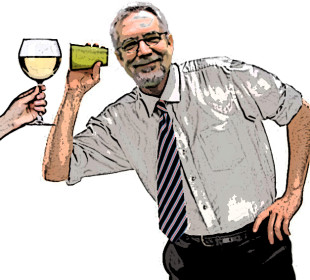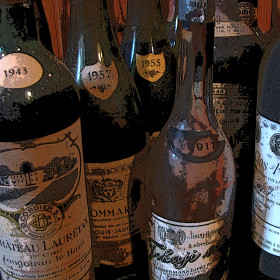The Wine Listener.
Chapter Two, Part One.
 Before I get to the obligatory blog about how to taste wine, I’d like to explain how you taste wine. You’re probably thinking, “It sounds like this guy has already tasted enough wine for one night” (and you’re absolutely right).
Before I get to the obligatory blog about how to taste wine, I’d like to explain how you taste wine. You’re probably thinking, “It sounds like this guy has already tasted enough wine for one night” (and you’re absolutely right).
What I’m trying to say is there are tasting-techniques to enhance your perceptions of wine, and in the next chapter I’ll explain how to use these procedures. This chapter will explore how your senses perceive aromas and flavors, or how you taste wine from a physiological point of view. Throughout this blog I’ve put in my five cents; this is where you pony up your five sense.
That’s right; to fully appreciate wine you use all five senses. So now you’re probably thinking, “Great. I’m reading a blog by some nutcase who listens to his wine.” Before you reach for the mouse you should know I only mention all five senses because nothing gets me salivating like Pavlov’s dog more than the sweet sound of a cork popping. You remember Pavlov’s slobberpuss dog from Psych 101 don’t you? He taught the world about conditioned reflexes. I learned about conditioned reflexes from my brother-in-law. Every time I open an expensive bottle of wine, he shows up.
After the cork has popped or the cap has crackled, not even a convoluted conversationalist like me can think of much to say about listening to wine so let’s move on to the other part of wine analysis that nobody cares about; the visual inspection.
I love the brilliant color of wine so much that I’ve added splashes of it to most of my ties. Wine comes in shades of red and white, which explains why my wife will only buy me shirts that are red or white. Wine can also be pink but my pink jokes are too blue for this site.
There are several things you can learn about a wine by studying its color, clarity and intensity, and these visual signs can tip you off regarding what you might expect to taste. I’ll delve deeper into that later, but for now I’ll simply say that wine should be enjoyed for its good looks as well as its other sensations.
Take time to appreciate the golden hue of aged Chardonnay, the warm, brick-like tones of mature Barolo, the brilliant purple reflections found in young Beaujolais or lose yourself in the tiny beads of bubbles in fine Champagne and you’ll come to realize wine is as eye-catching as it is mouth-watering. When you pour a lovely glass of wine it’s like going on a blind date and discovering its as beautiful as a super-model – but probably not as dense.
One of the prettiest wines I ever gazed upon was given to me by a little old lady from Hackensack, New Jersey. I remember the day she called and told me her dearly departed husband had left her with a basement full of old wine she wanted disposed of. I told her I was very busy and couldn’t possibly get there for three minutes.
Most of what I found was over the hill, but I did happen upon a bottle wrapped in an antique newspaper that was as brown and flaky as Phyllo dough on an over-baked baklava. Inside the brittle bundle I uncovered a bottle of 1917 Zimmermann Lipot, Tokaji Aszu. So enamored was King Louis XIV with Tokaji Aszu that he proclaimed this Hungarian dessert wine “The Wine of Kings and the King of Wines.” King Louis could turn a phrase almost as well as his famous siblings Huey and Dewey.
Although white, Tokaji Aszu has tremendous aging potential due to its sweetness and acidity.  The night I opened it, ten anxious guests looked on in rapt anticipation of my ancient wrapped libation. The wine had thrown so much sediment that I couldn’t see through the glass and had little clue as to its condition, but when I poured the golden elixir into the first glass there was a collective gasp at its dazzling color and clarity.
The night I opened it, ten anxious guests looked on in rapt anticipation of my ancient wrapped libation. The wine had thrown so much sediment that I couldn’t see through the glass and had little clue as to its condition, but when I poured the golden elixir into the first glass there was a collective gasp at its dazzling color and clarity.
The wine was a beautiful, deep golden hue and radiated yellow beams of light as if it were a multi-faceted gold ingot. As I swirled the wine, viscous legs of orange and gold lingered inside the glass, thumbing their collective noses at the laws of gravity.
As pretty as the wine was, my wife was convinced there must be some unwelcome organism living in any bottle that had spent 90 years in a Hackensack basement. I told her she was probably right and being a selfless kind of guy, I poured her share into my glass.
In an upcoming blog I’ll talk about how we perceive aroma (a perception that actually matters in wine appreciation) but until then remember this; when you approach a glass of wine, don’t rush through it like Nick Nolte through a DWI checkpoint. The road to inebriation begins with the scenery so pause to enjoy the view.























Wonderfully written! Enjoyed the show and ready for the next act!! Mike M
The next act stinks – that is to say I’m writing about olfaction. Thanks for the comment, I’m told Google likes them almost as much as I do!
Love the brother-in-law comment.
I did get a lot of feedback about that comment. I didn’t know so many people know my brother-in-law!